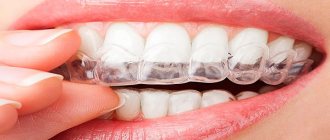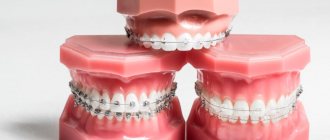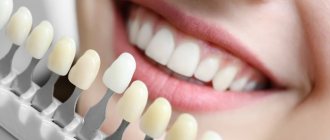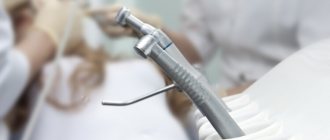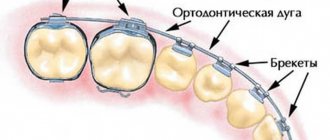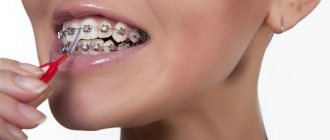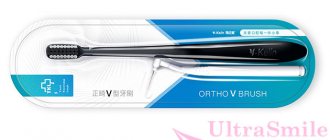Different types of braces Imaging diagnostic methods are necessary to identify diseases and make the correct diagnosis. One of the most popular is magnetic resonance imaging. The method is non-invasive, absolutely safe for health, and has a minimum of contraindications. One of the limitations is the presence of metal structures in the patient’s body. We are talking about endoprostheses, implants, pacemakers, hearing correction devices or orthodontic devices. The possibility of undergoing an MRI with braces or retainers is the most common reason for discussion, because... bite correction structures cannot be quickly removed without the help of a dentist.
Is it possible or not to do an MRI with braces on teeth?
Magnetic resonance imaging can be performed with braces on the teeth, however, when performing diagnostics, it is necessary to take into account some nuances:
- what material is the orthodontic structure made of?
- what part of the body is exposed to magnetic influence;
- Are there alternative diagnostic options?
MRI of the brain
It is possible to do an MRI of the brain with braces. In the manufacture of most modern orthodontic systems, metals are not used, which can affect the outcome of the diagnosis. It is necessary to check with your dentist exactly what alloys were used to make these braces.
Some metals may resonate with the magnetic field during diagnostic testing. This will result in the study being slightly biased. Therefore, it is important to have an idea of the technology for making corrective plates and, based on this, evaluate the feasibility of tomography.
With retainers installed
Retainers are thin metal plates that are installed on the inside of the tooth after the bite is corrected with braces. In most cases, they do not affect brain MRI readings.
Important!
Studies have shown that multi-wire retainers did not cause significant distortions in diagnostic results.
If tomography is performed in another area, the patient may not worry about the reliability of the results. With braces and retainers, they cannot be distorted, since the structures do not enter the magnetic field space.
What does a CT scan of the jaw show when diagnosing serious diseases?
As a diagnostic test, CT is also suitable for identifying fairly serious diseases. High-precision three-dimensional scanning allows you to identify pathology in the early stages and begin timely treatment.
Jaw cancer
It is a bulky neoplasm that can be found in epithelial tissues. It is not common, but according to statistics, jaw cancer is diagnosed in about 0.8% of the total number of people with malignant tumors. The disease can affect both the lower and upper jaw (here it is more common). The most common forms of pathology are osteogenic sarcoma and carcinoma.
Detection requires differential diagnosis using MRI and CT, as well as a pathomorphological examination of the material taken during biopsy. CT results show data that allows us to determine not only the nature of the tissue manifestation of the tumor, but also the boundaries of bone structures. Most importantly, tomography can reveal signs of infiltrative osteolysis.
Osteomyelitis of the jaw
It is expressed as an infectious-purulent inflammation that affects the jaw bones. It can be chronic and acute. Quite often, traumatic osteomyelitis can be diagnosed, which is a consequence of complications after injuries (for example, fractures) of the lower jaw. If ignored, the pathology can lead to the development of osteonecrosis.
Computed tomography is a priority technique for timely diagnosis of the disease. CT scan of the jaw shows:
- volume of affected bone tissue;
- the condition of the soft tissues surrounding the affected bones;
- form of the disease - limited, widespread or diffuse;
- degree of subperiosteal spread.
As a result, the attending dentist is able to determine what phase the disease is in - exacerbation or remission.
The Smile Factor network of clinics invites residents and guests of St. Petersburg for dental diagnostics using innovative equipment with minimal radiation exposure.
How do metal parts react when examined in a tomograph?
There is a stereotype that tomography cannot be done with metal braces. Reviews from some patients indicate that the structure is attracted by a magnet, heats up, emits harmful substances and can completely deteriorate. These myths are supported by people's imagination, since none of the hypotheses have been confirmed.
On a note!
A person with braces does not feel anything unusual during an MRI of the head. The examination is the same as without orthodontic construction. Nothing gets hot, explodes or gets damaged.
Patient misconceptions about the effect of magnets on braces
Some patients refuse the procedure because they consider MRI and a retainer (braces) to be incompatible. Main misconceptions:
- if you do a magnetic examination with an orthodontic design, the result will be unreliable, and the examination itself will be useless;
- the magnetic tomography device affects the tension force of the corrective arc, after which the staples become useless;
- when exposed to a magnetic field, the metal releases toxic substances that are dangerous to humans;
- when manipulated, the plates heat up and can peel off from the tooth;
- a magnet can attract locks and arches, so doing an examination is dangerous.
Important!
None of the assumptions has a scientific evidence base, so they are all considered patient misconceptions. If there are concerns about the effectiveness and safety of this diagnosis, it is worth listening to the opinions of several specialists.
Common Misconceptions
Among patients themselves and on Internet forums, you can come across a lot of statements regarding the compatibility of MRI examination and braces.
Many of them are shocking with negative consequences for human health, others talk about obtaining a 100% inaccurate result. Much of the information is inaccurate and unsubstantiated.
The most common misconceptions are:
- During examination, the metal becomes quite hot and magnetized , causing the structure of the braces to collapse. In reality, nothing like this happens. Magnetic radiation does not heat up the correction device, and the magnetization effect is so small that it is not felt.
- Metal parts may damage tooth enamel during examination .
Modern braces are small in size and cannot move and injure the oral cavity during the diagnostic process. Only large structural elements made entirely of metal can become very hot, move and cause injury to the oral cavity. But today, in the manufacture of large parts, paramagnetic materials, which are passive in relation to the magnetic field, are usually used. - The result of the study will be greatly distorted .
This statement is only half accurate. Braces can affect the results and interfere with the diagnosis of only the part of the body in which they are installed. Therefore, if you perform an MRI of the head with an orthodontic system installed, the results will indeed be incorrect. In this case, radiography or angiography will be more informative. - During diagnosis, the patient feels electric shocks . In addition, they say that hot braces leave burns on the mucous membrane and soft tissues. In practice, not a single similar case has been recorded. The examination is absolutely painless.
Sometimes patients feel slight discomfort from lying on a hard surface for a long time, fatigue, and numbness due to being in one position for a long time. When a contrast agent is injected to confirm the diagnosis, you may feel cold during its administration.
Important! In isolated cases, there is a slight tingling sensation in the body, warmth in the examined area, slight dizziness, nausea, vomiting, and headache. These phenomena are considered in medicine to be a normal reaction of the body to the procedure.
The only negative consequence of MRI is a distortion of the actual picture of the patient’s health condition.
A physician will not be able to make an accurate diagnosis based on tomography data or select an acceptable treatment for a particular patient. The procedure does not pose any risk to the health, much less the life of the person being examined!
In the video, a specialist will express his opinion on the possibility of performing an MRI in the presence of braces.
An alternative method of examination with braces is CT
Computed tomography is an alternative to magnetic scanning. The main difference between them is that MRI uses magnetic influence, while CT uses X-rays.
You can do a CT scan with braces. Orthodontic treatment is not a significant contraindication for examination. The only nuance that experts take into account is the material used to make the correction system. During an x-ray, it can be recorded by the system. Therefore, when interpreting the results, it is necessary to pay attention to the error. Automatic interpretation of results may be distorted and show a pathological process where it actually does not exist.
general information
The operation of an MRI tomograph is based on magnetic potential - the device generates a field that affects tissue. When the waves pass, the hydrogen atoms in the human body change and are recorded by the sensors of the device. The received signals are read by a tomograph, the information is processed in a computer and converted into an image.
The concentration of hydrogen atoms is not constant depending on the area of the body, and accordingly the magnetic field changes differently.
MRI
Therefore, the picture on the screen appears in the form of outlines of organs, borders, tissue and muscle spaces, vessels and nerves, and inflammation are displayed on the monitor.
Reviews
In the capital, almost every medical institution has a tomograph and everyone is examined indiscriminately. When I was scheduled for pelvic diagnostics, I had braces. I thought that the procedure would be postponed until the end of treatment or the plates would be removed ahead of schedule. But the doctor convinced that the braces would not interact with the magnetic field, since it affects a completely different area.
Inna, Moscow
They ordered a head examination, and I had braces. There was no time to wait, since a dangerous diagnosis was in question. I found out from the dentist that my braces are made of plastic and there are no metal parts in them. Therefore, I did the procedure without fear and did not regret it. The primary diagnosis was not confirmed.
Egor, Krasnodar
Are there any obstacles to examining other parts of the body?
It is not relevant to examine the head with braces when diagnosing the cerebrum, blood vessels, sensory organs and sinuses. Metal implants only interfere with this part of the body.
There are no obstacles to examining the organs of the chest and abdominal cavity, and joints of the limbs.
In this case, the braces are not influenced by the magnetic field and are not able to interfere with the information content of the procedure.
Braces do not cause any harm to the body, but only reduce the quality of the images.
It makes no sense to do an MRI of the head with steel structures; in other cases, the study is carried out. If there are contraindications, the constructs are removed and CT or ultrasound angiography is performed.

